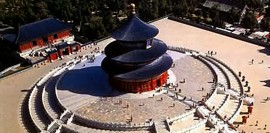 The Ming Dynasty lasted from 1368 to 1644. The first Ming emperor had his tomb built in Nanjing, the town which he had chosen for his capital. As his eldest son died early, he was succeeded by his grandson, who became the second emperor. His fourth son, the Prince of Yan, was guarding the northern frontier near Beijing with an army 100,000 strong. The second emperor attempted to weaken his forces but was met with counter-attacks. After a 3-year war he was ousted and lost track of completely. So, the fourth son became the third emperor, Emperor Yongle, of the Ming Dynasty.
The Ming Dynasty lasted from 1368 to 1644. The first Ming emperor had his tomb built in Nanjing, the town which he had chosen for his capital. As his eldest son died early, he was succeeded by his grandson, who became the second emperor. His fourth son, the Prince of Yan, was guarding the northern frontier near Beijing with an army 100,000 strong. The second emperor attempted to weaken his forces but was met with counter-attacks. After a 3-year war he was ousted and lost track of completely. So, the fourth son became the third emperor, Emperor Yongle, of the Ming Dynasty.
The site was chosen with the greatest care, with geomancy taken into account. The tombs are located about 50 kilometres to the north of Beijing. They are scattered over a basin approximately 40 square kilometres in area, screened by mountains on three sides and open to the Beijing Plain in the south. The road leading to the tombs is guarded by the Tiger Hill on the left and the Dragon Hill on the right. It was a forbidden ground except for those who were officially in charge of its upkeep. It was not allowed to cultivate land, cut wood or to take stones from here. No one could enter it on horseback, even the emperor himself had to dismount at the gate.


 About Beijing
About Beijing 


